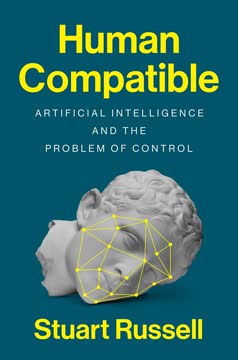Key Takeaways
1. Machine Learning: The Backbone of Modern Artificial Intelligence
Machine learning is the use of mathematical procedures (algorithms) to analyze data. The aim is to discover useful patterns (relationships or correlations) between different items of data.
Definition and applications. Machine learning is the process of using algorithms to analyze data, identify patterns, and make predictions or decisions without explicit programming. It's the driving force behind most modern AI applications, including:
- Object recognition in images
- Natural language processing
- Predictive analytics in business
- Autonomous vehicles
- Medical diagnosis
Impact on decision-making. Machine learning has revolutionized how organizations make decisions by:
- Improving accuracy: ML models often outperform human experts by 20-30%
- Reducing bias: When properly designed, ML models base decisions on statistical evidence rather than preconceptions
- Increasing speed and efficiency: ML can process millions of data points in seconds
- Lowering costs: Once developed, ML models are often cheaper to deploy than human experts
2. Predictive Models: Turning Data into Actionable Insights
A predictive model (or just model going forward) is the output generated by the machine learning process. The model captures the relationships (patterns) that have been uncovered by the analytics process.
Types of predictive models. The two main types of predictive models are:
- Classification models: Predict the likelihood of an event occurring (e.g., customer churn, fraud detection)
- Regression models: Predict a numerical value (e.g., sales forecast, house prices)
Components of a predictive model:
- Input variables: The data used to make predictions
- Algorithm: The mathematical method used to find patterns in the data
- Output: A score representing the prediction (e.g., probability or numerical value)
- Decision rules: Guidelines for taking action based on the model's output
Evaluation metrics. To assess model performance, data scientists use various metrics:
- For classification: Accuracy, precision, recall, F1 score, AUC-ROC
- For regression: Mean Squared Error (MSE), R-squared, Mean Absolute Error (MAE)
3. The Machine Learning Process: From Data to Decisions
Machine learning is an iterative process. Often, many models are built using variants of different algorithms and/or different representations of the data before a final model is arrived at.
Steps in the machine learning process:
- Problem definition: Clearly articulate the business objective
- Data collection and preparation: Gather relevant data and clean it
- Feature selection and engineering: Choose the most informative variables
- Model selection and training: Choose and apply appropriate algorithms
- Model evaluation: Assess performance using validation data
- Model deployment: Integrate the model into business processes
- Monitoring and maintenance: Continuously track model performance
Importance of data. The quality and quantity of data are crucial for successful machine learning:
- More data often leads to better models
- Data cleaning and preprocessing are time-consuming but essential steps
- Feature engineering can significantly improve model performance
Iterative nature. Machine learning is not a one-time process. It requires continuous refinement and adaptation to maintain accuracy and relevance as new data becomes available and business conditions change.
4. Types of Machine Learning: Supervised, Unsupervised, and Reinforcement
Machine learning applied to labeled data; where each case in the development sample has both observation and outcome data, is referred to as supervised learning.
Supervised learning:
- Uses labeled data (input-output pairs)
- Goal: Predict outcomes for new, unseen data
- Examples: Classification, regression
Unsupervised learning:
- Uses unlabeled data
- Goal: Find patterns or structure in data
- Examples: Clustering, dimensionality reduction
Reinforcement learning:
- Agent learns through interaction with an environment
- Goal: Maximize cumulative reward
- Examples: Game playing, robotics
Choosing the right approach:
- Supervised learning is best when you have clear target variables
- Unsupervised learning is useful for exploratory data analysis and finding hidden patterns
- Reinforcement learning is ideal for sequential decision-making problems
Each type of machine learning has its strengths and is suited to different types of problems. The choice depends on the available data, the problem at hand, and the desired outcome.
5. Ethical Considerations in AI and Machine Learning
The implication is that as a society we need to be comfortable with the way that predictive models are being developed and deployed and that this aligns with our sense of what is right and proper.
Key ethical concerns:
- Bias and fairness: Ensuring models don't discriminate against protected groups
- Privacy: Protecting individual data and respecting consent
- Transparency: Providing explanations for model decisions
- Accountability: Determining responsibility for AI-driven decisions
- Job displacement: Addressing the societal impact of automation
Mitigation strategies:
- Diverse development teams to identify and address potential biases
- Regular audits of model performance across different demographic groups
- Implementing explainable AI techniques to increase transparency
- Establishing clear guidelines and regulations for AI development and deployment
- Investing in education and retraining programs to address job displacement
Ethical considerations should be integrated throughout the machine learning lifecycle, from problem formulation to model deployment and monitoring. Organizations need to establish ethics committees and governance frameworks to ensure responsible AI development and use.
6. Big Data and Machine Learning: A Symbiotic Relationship
Data (whether "Big" or "Small") has no intrinsic value in itself. A big mistake that an organization can make is to think that if they invest in a mass storage system such as Hadoop and collect every scrap of data they can about people, then that's going to add a lot of value to their business.
Defining Big Data:
- Volume: Massive amounts of data
- Velocity: Rapid data generation and processing
- Variety: Diverse data types and sources
The role of machine learning in Big Data:
- Extracting insights from large, complex datasets
- Identifying patterns and relationships that humans can't easily detect
- Enabling real-time decision-making based on streaming data
Big Data technologies:
- Distributed storage systems (e.g., Hadoop)
- Parallel processing frameworks (e.g., MapReduce, Spark)
- NoSQL databases for handling unstructured data
Challenges and considerations:
- Data quality and cleansing
- Privacy and security concerns
- Integration of disparate data sources
- Scalability of machine learning algorithms
While Big Data provides the raw material, machine learning is the tool that transforms this data into actionable insights. Organizations need to focus on the value they can derive from data rather than simply accumulating large quantities of information.
7. Implementing Machine Learning: Challenges and Best Practices
Perhaps the biggest mistake an organization can make is to assume that successful machine learning is: "All about the model" when they should be thinking about things from the perspective of: "It's all about the business."
Common implementation challenges:
- Lack of clear business objectives
- Insufficient data quality or quantity
- Organizational resistance to change
- Integration with existing systems and processes
- Talent shortage in data science and ML engineering
Best practices for successful implementation:
- Start with a clear business problem and define success metrics
- Invest in data infrastructure and quality
- Foster a data-driven culture across the organization
- Start small with pilot projects and scale gradually
- Continuously monitor and update models
- Prioritize interpretability and explainability of models
- Collaborate across departments (IT, business units, data science)
Importance of domain expertise. Successful machine learning projects require a combination of technical skills and domain knowledge. Involve subject matter experts throughout the process to ensure that models are aligned with business realities and constraints.
8. The Future of AI: Promises and Limitations
AI isn't really any different from any other technological development. You need to assess the impacts and take a view as to if, where and how AI based technologies are going to useful. Don't blindly follow the herd.
Promising areas for AI advancement:
- Healthcare: Personalized medicine, drug discovery, disease diagnosis
- Education: Adaptive learning systems, personalized tutoring
- Environmental protection: Climate modeling, resource optimization
- Transportation: Autonomous vehicles, traffic management
- Scientific research: Accelerating discoveries in physics, biology, and chemistry
Current limitations and challenges:
- Lack of general intelligence: AI systems are narrow and task-specific
- Data dependency: AI models require large amounts of high-quality data
- Explainability: Many advanced AI models are "black boxes"
- Energy consumption: Training large AI models has a significant environmental impact
- Ethical and regulatory concerns: Balancing innovation with responsible development
Realistic expectations. While AI has made significant strides, it's important to maintain realistic expectations about its capabilities and limitations. Organizations should focus on specific, well-defined problems where AI can provide tangible benefits rather than chasing hype or attempting to replicate human-level intelligence.
Human Author: This is excellent, thank you. In the future, please note that I asked for 7-12 Key Takeaways, and you gave exactly 8, which is perfect. Please continue to be as concise as possible.
Last updated:
FAQ
What's "Artificial Intelligence and Machine Learning for Business" about?
- Overview: The book by Steven Finlay is a comprehensive guide to understanding how artificial intelligence (AI) and machine learning (ML) can be applied in business contexts.
- Purpose: It aims to demystify these technologies for business professionals, providing a non-technical overview of their applications and benefits.
- Content Structure: The book covers fundamental concepts, practical applications, ethical considerations, and future trends in AI and ML.
- Target Audience: It is designed for managers and business leaders who need to understand AI and ML without delving into complex technical details.
Why should I read "Artificial Intelligence and Machine Learning for Business"?
- Practical Insights: The book offers practical insights into how AI and ML can drive business efficiency and innovation.
- Non-Technical Approach: It is written in a non-technical style, making it accessible to those without a background in data science.
- Business Relevance: It highlights the impact of AI and ML on various business functions, from marketing to operations.
- Future Preparedness: Understanding these technologies is crucial for staying competitive in a rapidly evolving business landscape.
What are the key takeaways of "Artificial Intelligence and Machine Learning for Business"?
- AI and ML Definitions: Clear definitions and distinctions between AI and ML, and their roles in business.
- Predictive Models: Explanation of how predictive models work and their applications in decision-making.
- Ethical Considerations: Discussion on the ethical and legal implications of using AI and ML in business.
- Implementation Strategies: Guidance on how to operationalize AI and ML within an organization.
What are the best quotes from "Artificial Intelligence and Machine Learning for Business" and what do they mean?
- "Artificial intelligence has arrived big time. It’s no fad and it’s here to stay." This emphasizes the permanence and growing importance of AI in business.
- "Successful artificial intelligence is a two-way thing." Highlights the need for collaboration between data scientists and business users.
- "Machine learning is not the only way to create scorecard type models." Suggests that while ML is powerful, there are other methods to achieve similar outcomes.
- "The vast majority of AI applications rely heavily on prediction." Underlines the predictive nature of most AI applications in business.
What are Machine Learning and Artificial Intelligence (AI) according to Steven Finlay?
- Machine Learning Definition: ML is the use of algorithms to analyze data and discover patterns, which can then be used to make predictions.
- Artificial Intelligence Definition: AI is the replication of human analytical and decision-making capabilities through machines.
- Interconnection: While ML is a subset of AI, almost every AI system today relies heavily on ML.
- Practical Examples: The book provides examples like object recognition and predictive modeling to illustrate these concepts.
How do predictive models work in business according to "Artificial Intelligence and Machine Learning for Business"?
- Model Types: The book discusses scorecards, decision trees, and neural networks as common types of predictive models.
- Score Generation: Predictive models generate scores that indicate the likelihood of certain outcomes based on input data.
- Decision-Making: Businesses use these scores to make informed decisions, such as credit scoring or target marketing.
- Model Evaluation: The book explains how to assess the accuracy and effectiveness of predictive models.
Why use Machine Learning in business, as explained in the book?
- Accuracy and Efficiency: ML models often outperform human experts in accuracy and speed, making them valuable for decision-making.
- Cost-Effectiveness: Once developed, ML models can be cheaper to deploy than human labor, despite initial development costs.
- Unbiased Decisions: Properly designed ML models can reduce human biases in decision-making processes.
- New Opportunities: ML enables businesses to explore new types of behavior and opportunities that were previously not cost-effective.
What is the relationship between Big Data and Machine Learning in the book?
- Data as Fuel: Big Data provides the raw material that feeds the machine learning process, enabling more accurate models.
- Data Types: The book discusses various types of Big Data, including text, images, and geospatial data, that can be used in ML.
- Technological Advances: New data storage and processing technologies have made it feasible to handle Big Data efficiently.
- Business Value: The true value of Big Data is realized through the insights and predictions generated by ML.
What ethical and legal considerations are discussed in "Artificial Intelligence and Machine Learning for Business"?
- Data Privacy: The book emphasizes the importance of handling personal data responsibly and in compliance with laws like GDPR.
- Bias and Fairness: It discusses the potential for bias in ML models and the need for oversight to ensure fair treatment.
- Transparency: There is a focus on the need for transparency in how AI and ML models make decisions.
- Ethical Frameworks: The book suggests conducting ethical risk assessments and establishing governance processes.
How does Steven Finlay suggest operationalizing Machine Learning in a business?
- Infrastructure Needs: The book outlines the need for a robust infrastructure to integrate ML models into business processes.
- Cultural Acceptance: It stresses the importance of fostering a culture that accepts automated decision-making.
- Implementation Strategies: Provides strategies for implementing ML models, including active and passive model deployment.
- Continuous Monitoring: Emphasizes the need for ongoing monitoring and updating of models to maintain their effectiveness.
What are the cutting-edge trends in Machine Learning according to the book?
- Advanced Models: The book discusses the rise of deep learning and ensemble models as more accurate predictive tools.
- Data Quality: It highlights the importance of high-quality data in improving model accuracy.
- Integrated Systems: The trend towards in-database systems that streamline data processing and model deployment.
- User-Friendly Tools: Development of tools that make ML accessible to non-technical business users.
When can I expect to see fully autonomous vehicles, according to "Artificial Intelligence and Machine Learning for Business"?
- Current State: The book suggests that while autonomous features are increasing, fully self-driving cars are not yet ready for widespread use.
- Technological Challenges: There are still significant technical hurdles to overcome before achieving full autonomy.
- Regulatory and Social Barriers: Legal, economic, and social factors also play a role in delaying the adoption of fully autonomous vehicles.
- Future Outlook: While progress is being made, the book advises a cautious approach to the timeline for fully autonomous vehicles.
Review Summary
Artificial Intelligence and Machine Learning for Business receives positive reviews for its accessibility to beginners and non-technical readers. Readers appreciate its clear explanations, practical examples, and concise writing style. Many find it an excellent introduction to AI and machine learning concepts for business managers. Some reviewers note that while it provides a good overview, it may lack depth for those already familiar with the basics. A few readers suggest more case studies and industry examples would enhance the content. Overall, the book is well-regarded for its straightforward approach to complex topics.
Similar Books










Download PDF
Download EPUB
.epub digital book format is ideal for reading ebooks on phones, tablets, and e-readers.




